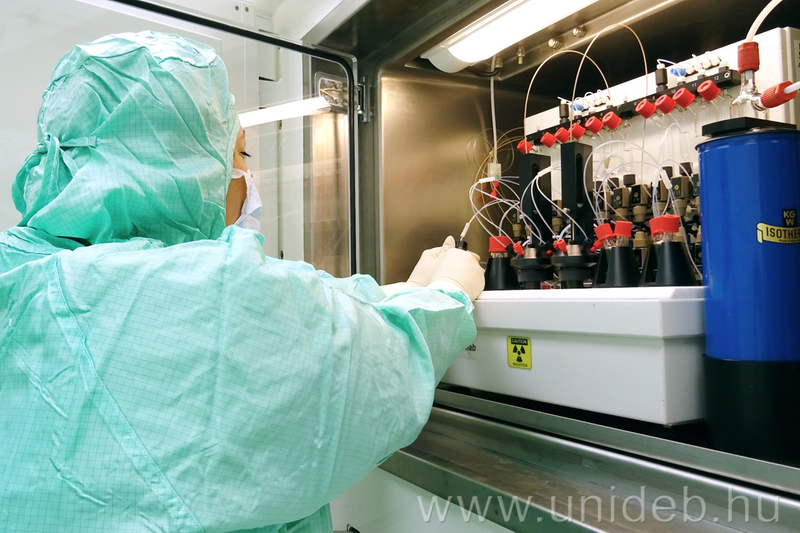PET (Positron Emission Tomography) scans using radiolabeled glucose are indispensable for diagnosing cancer patients and accurately determining therapy. The first PET scan in Hungary was performed in Debrecen in 1994. Since then, Debrecen University has played a role in the launch of all PET examination sites in the country through knowledge transfer or human resource provision.
Technological advancements have led to the integration of PET scans with CT (computed tomography), resulting in the widespread use of hybrid PET-CT devices. The first Hungarian PET/CT scan was also performed with a radiopharmaceutical produced at the University of Debrecen in 2005. Since then, this special diagnostic substance produced at the University of Debrecen’s Medical Imaging Clinic has been used not only for diagnosing domestic cancer patients but also for those in Transylvania.
The institution plays a decisive role in the production of radiopharmaceuticals for PET-CT examinations in Transylvania, and since radiopharmaceutical production is not yet available in Transylvania, meeting the demand represents a significant challenge for the production taking place at the University of Debrecen. For this reason, it has become necessary to expand production capacity, and it is important to deliver the radiopharmaceuticals produced here to as many foreign examination sites as possible.
Positron emission tomography (PET) is primarily used in the diagnosis of cancer. During the examination, a molecule labeled with a radioactive isotope (radiopharmaceutical or radiotracer) is injected into the patient, and its distribution within the body is performed using a PET device that detects radiation, thus allowing the detection of pathological processes. The radioactive material required for the radiopharmaceutical is produced in particle accelerators (cyclotrons) at three locations in the country, including the Nuclear Medicine Unit of the Medical Imaging Clinic, the University of Debrecen Clinical Center.
One of the most commonly used diagnostic substances is 18F-fluorodeoxyglucose (FDG). In 2005, the first Hungarian PET/CT examination was also performed with FDG produced in Debrecen. The radiochemistry department has already supplied FDG to various institutions in the country, including Budapest, Szeged, Gyula, Kecskemét, and Kaposvár – said Norbert Pótári, head of radiochemical production.
The transportation of the special radiopharmaceutical and the production of the appropriate quantity requires careful planning. The half-life of FDG is only two hours, meaning that the activity of the started material decreases by fifty percent every two hours.
PET is a bit more complex than traditional imaging diagnostics due to the radiopharmaceutical. For example, in CT, a contrast agent is used, which is easily accessible and the required amount can be precisely determined. In radiochemistry, this is a more complex process. Due to the two-hour half-life of the radiopharmaceutical, production must take into account factors such as the distance to which the radiopharmaceutical is transported and the number of examinations the institution wants to perform. It is necessary to calculate very precisely what quantity to produce so that the customer receives material with the appropriate activity – explained László Balkay, scientific advisor, and physicist at the Medical Imaging Clinic, University of Debrecen Clinical Center.
Careful planning and preparation make it possible for the radiochemistry department to supply radiopharmaceuticals for examinations to PET centers hundreds of kilometers away, not only domestically but also abroad. In the future, they would like to increase their capacity so that the special diagnostic substance produced at the University of Debrecen can be used in as many PET centers as possible for the diagnosis of cancer patients.
The increasing demand in Romania is well illustrated by looking at the trend this year.
At the beginning of the year, we typically produced 10-15 FDG per week, which we supplied to the PET centers in Debrecen, Cluj-Napoca, and Timișoara. We usually supplied Debrecen and Cluj-Napoca 1-2 times a day, and Timișoara once a day. During the year, we also had to supply FDG to two new PET centers: Oradea and Târgu Mureș, for now, 1-2 times a week. From 2025, their FDG demand is expected to increase, but Cluj-Napoca has also indicated that a new PET/CT examination site will be launched. Meeting the current demand is already possible only with night shifts – added Norbert Pótári.
The Nuclear Medicine Unit of the Medical Imaging Clinic, University of Debrecen Clinical Center, currently produces five molecules for diagnostic use (18F-FDG, 18F-FET, 11C-methionine, 11C-choline, 68Ga-PSMA), which have marketing authorization approved by the National Institute of Pharmacy and Nutrition.
(unideb.hu)


















